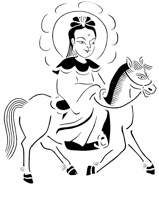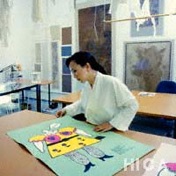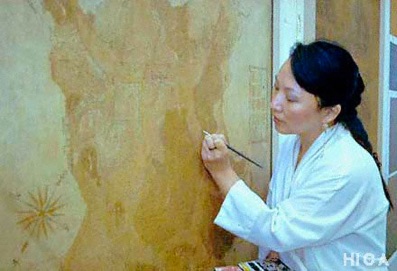HICA



Berichte und Interviews / Reports and Interviews


Portrait of a Restorer:
an Interview with Hua Hai-Yen
Portrait einer Restauratorin:
ein Interview mit Hua Hai-Yen
Ye Ziyin
The Paper Museum Magazine, Spring Issue, 3/31/1996, Taipei, Taiwan
Hua Hai-Yen is a restorer of both western and oriental works of art, who has her own workshop in Mannheim, Germany. In this interview she will talk about her training in Europe and its difference with the situation in Taiwan, where restoration is still mainly seen as a minor craft. Moreover, Ms. Hua will elaborate on her experiences and the technical as well as the more emotional sides of restoration.
Work that demands thoroughness from start to finish
Hua: The restorer needs to adapt an attitude of "thoroughness" in his or her work. I learned to adopt this attitude after I left Hong Kong and went to Switzerland to study. When I was studying at the Basel Arts Academy the teachers were extremely dedicated and thorough in their approach. I remember that at the time the level of the students was quite high. Some of them had already considerable experience and a somewhat haughty attitude. However, on the first day of our course, every bit of pride was quickly suppressed by the teachers. They wanted nothing else from the student but an attitude that can only be described as "thorough". For instance, for the class "pencil drawing" every student could only use one sheet of paper, one pencil and one eraser. Every day the work for this class would follow the same pattern: drawing, erasing, drawing again, erasing again. After a few months we were still drawing the same drawing on the same sheet of paper. I was steadily growing impatient with the whole business of endless drawing, yet my teacher just looked at my work and commented: "It's not ready yet! Continue!". For the study of colour we would only use 5 basic colours together with black and white to produce other colours. During the four years of training the emphasis was on developing a thorough attitude toward one's work through continued training, using the most simple and basic materials.
Apart from thoroughness, restoration requires constant concentration
Many years ago, I returned to Taiwan to visit my family. At the time, someone had presented my parents with a painting. When I took it to be mounted I was able to follow the complete process of mounting the painting. Some time after the painting had been mounted a greyish discolouring occurred. I was curious about this change, and it set me thinking about the best methods for mounting a painting. This incident was actually one of the reasons why I decided to study restoration. It is this curiosity and an analytical mind that are perhaps the most important requirements to become a restorer.
Because when you accept a piece for restoration it is the analysis and the planning of the process of restoration that are the most difficult and time-consuming.
When we receive a work of art for restoration, we have to determine the date of creation, its historical background, the style of the artist and consequently read a substantial amount of source material, followed by an overall analysis of the state of the work, and only after this has been completed we can plan the process of restoration and the actual work can start.
In my opinion a careful start will eliminate most problems during the restoration. Yet, this does not mean that the process will go exactly as planned. Indeed, sometimes many problems may arise during the actual restoration work. The work does therefore involve a large amount of stress for the individual restorer. However, the fact that every step in the process is so delicate, makes me calm down and prevents me from becoming too strained.
Not everyone can become a restorer
Hua: I think that in order to become a restorer you need to be equipped with some innate qualities. First, you must be interested in objects from the past. Because of this interest, your work will continue to fascinate you, even if you have spend hundreds of hours on restoring one old map. Other qualities that a restorer needs to have are: patience; an analytic mind; a profound interest in art; a practical knowledge of painting; being able to cope with solitude, as well as honesty. The latter is of importance when we mount an old painting and we discover a hidden treasure, for instance an old map, behind this painting. One should therefore strive to become a reliable restorer, apart from skills and attitude, professional ethics should also be taken into account.
Spiritual interaction between the artist and the restorer
Hua: Before restoring an old painting you need complete mental preparation, and this is what attracts me most in my work. I can actually feel that I have a spiritual interaction with the artist. Especially when you have restored several works by one artist, there is a profound understanding and the feeling of direct communication with the artist. The more we understand a work of art, the more we are able to feel this spiritual interaction. I enjoy this feeling, and over the years the restoration of western and oriental works of art has made my communication with the ancients so intense, that I sometimes find it difficult to communicate with modern man.
(Ms. Ye Ziyin is a journalist with the Li Jizhun Radio Station in Taipei)

